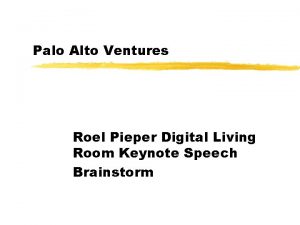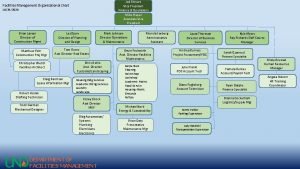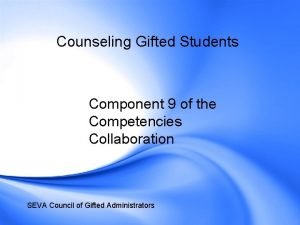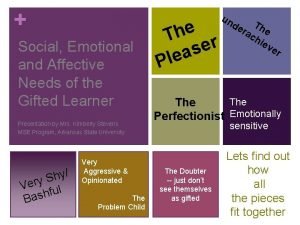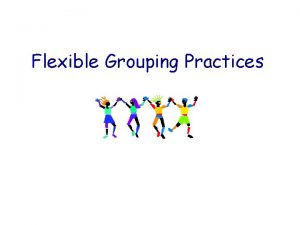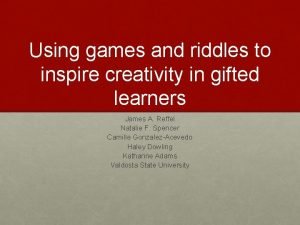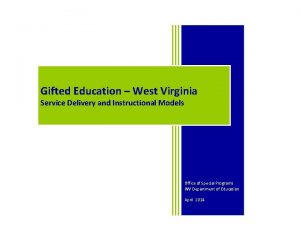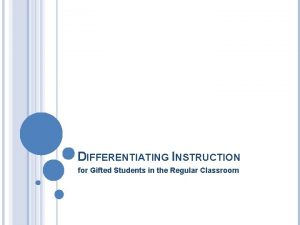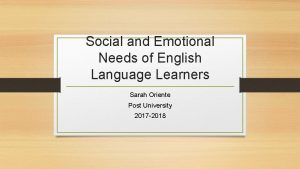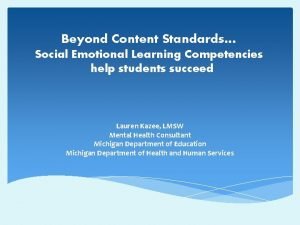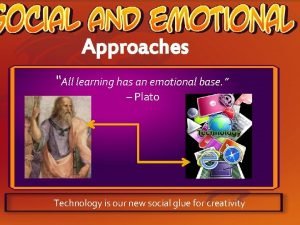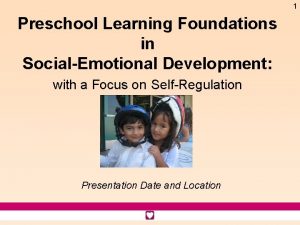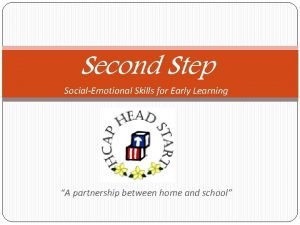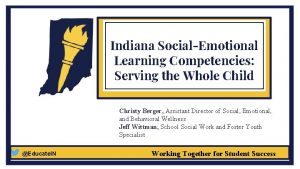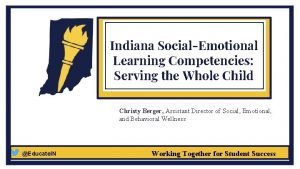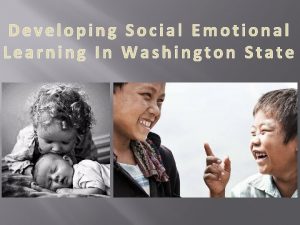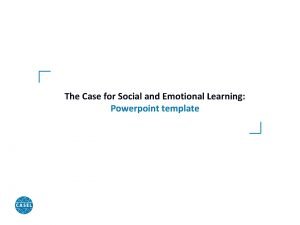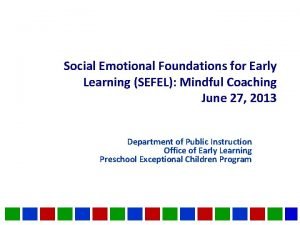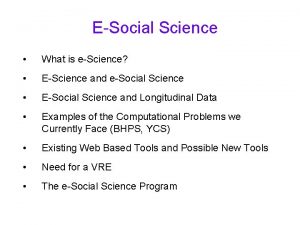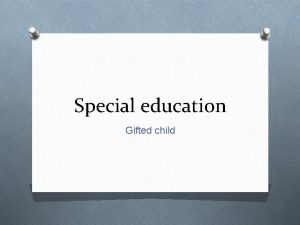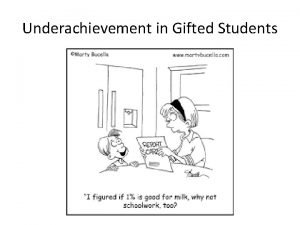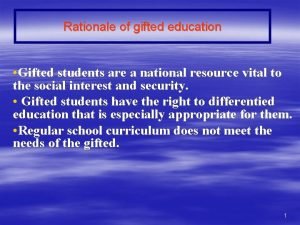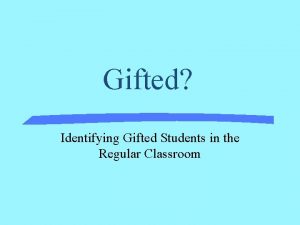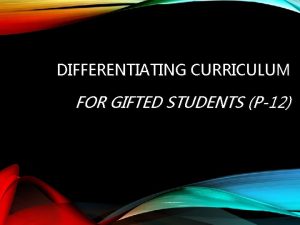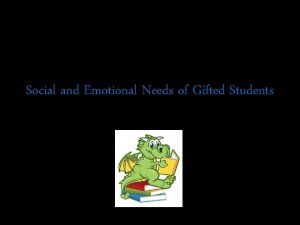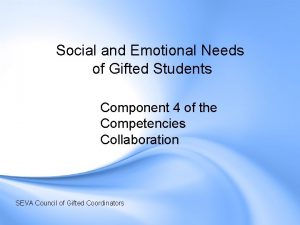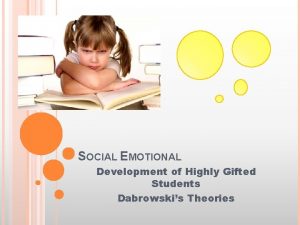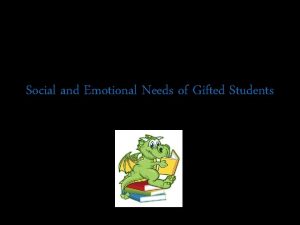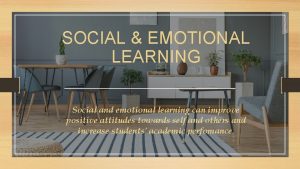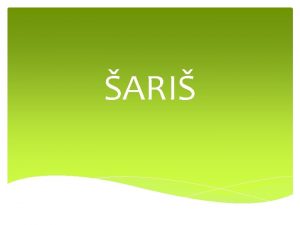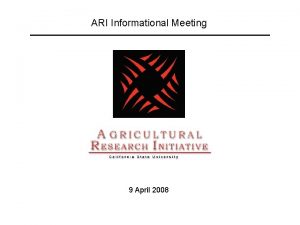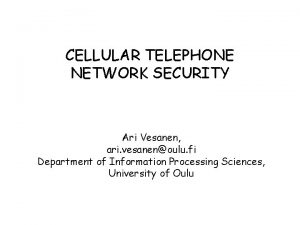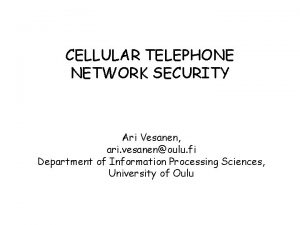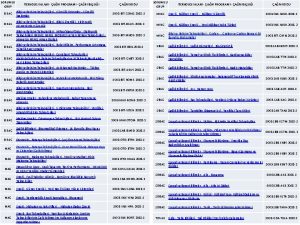ESOCIAL EMOTIONAL LEARNING FOR GIFTED STUDENTS Ari Pieper











































- Slides: 43

ESOCIAL EMOTIONAL LEARNING FOR GIFTED STUDENTS Ari Pieper and Dawn Tenev Metrolina Regional Scholars Academy

VISION FOR OUR STUDENTS Intellectual Engagement Social Awareness Insightful thinkers Compassionate Secure Life long learners Self aware Prepared Thoughtful contributors Flexible Balanced Emotional Confidence

WHY GIFTED KIDS NEED SOCIAL EMOTIONAL LEARNING Perfectionism Asynchronous Development Underachievement Anxiety and Depression Oversensitivity

COLLABORATIVE FOR ACADEMIC, SOCIAL AND EMOTIONAL LEARNING (CASEL) 1. Self-awareness: the ability to identify our own feelings, as well as how our feelings and thoughts influence what we do 2. Self-management: the ability to manage our feelings, thoughts, and behaviors in a variety of contexts 3. Social awareness: the ability to understand empathize with others' points of view 4. Relationship skills: the ability to communicate and connect with a range of people in a healthy way 5. Responsible decision making: the ability to make positive choices about how we behave

EXECUTIVE FUNCTION


GROWTH MINDSET

INSTRUCTIONAL PROGRAM

SEL EVERY DAY! K-4 Instructional Program 5 -8 Instructional Program 3 days of instruction 2 days of instruction 1 day of classroom meeting 2 days of advisory 1 day of buddies or assembly

SECOND STEP LESSONS FOR ELEMENTARY Homeroom teacher with one additional teacher in the classroom to support instruction Curriculum based instruction on topics such as: Friendship Emotional Management Empathy Feelings Self Talk

THEME BASED SEL FOR MIDDLE SCHOOL Small groups : 6 weeks per theme, rotate among all teachers 1. Citizenship 2. Self-care 3. Leadership 4. Conflict Resolution 5. Purpose 6. Cyber/Social Media Awareness

SEL AWARDS

BUDDIES AT SCHOLARS ACADEMY 5 th and 1 st graders work together to create care packages for Hospitality House of Charlotte. They also made cards and stationery sets.

SERVICE LEARNING AND GIFTED EDUCATION Benefits of Service Learning for Gifted Education ● ● Gifted students need “to work independently, at a faster pace, [with] in-depth content, to interact with adult professionals or mentors, and to learn to research and to apply a variety of problemsolving strategies” (Sorenson and Francis 1988) As said by Harry Passow “Gifted children have the potential for greater and more profound social, moral, and ethical concerns. We need to nurture this potential. We talk of the gifted exercising future leadership but seldom design educational programs that will help them develop the skills, the motivation, and the values of leadership. ” (1988) Steps to Service Learning Step 1: Preparation / Planning ● ● Identifying the community need(s) to be addressed Selecting and planning the specific service to be completed. Identifying and enlisting the assistance of community service agencies. Providing content area instruction and specific training students will need to conduct the service activity. Step 2: Service / Learning Step 3: Reflection / Application Step 4: Evaluation / Recognition

SERVICE LEARNING AT SCHOLARS ACADEMY Loaves and Fishes Canned Food Drive - “CAN” Structure! Our fourth grade conducted a can food drive during the month of February, and are using the cans to construct a replica of our school building.

SEL - 1 ST GRADE LESSON ON SELF TALK FOR LEARNING Lesson taken from Second STEP program Lesson Concepts: ● Self -talk means talking to yourself out loud in a quiet voice or inside your head. ● Self-talk helps you focus on maintaining attention Objective: ● Students will be able to demonstrate self-talk strategies for remembering directions. Purpose of Lesson: ● Self-talk is a developmentally appropriate strategy students can use to help themselves listen, follow directions, and stay on task. ● Over time, self talk typically becomes internalized and no longer spoken out loud. ● Self-talk is a powerful tool to help students remember directions and focus and guide their efforts. ● Self-talk can be a helpful strategy for controlling students’ emotions and encouraging themselves to be persistent.

SEL - 1 ST GRADE LESSON ON SELF TALK FOR LEARNING

3 RD GRADE UNIT WITH LESSONS ON GROWTH MINDSET Typical responses from students about failure: I tried, but I failed. I am a failure. Missed opportunity. I am stupid. It won’t work I didn’t win and someone else did. I came in last. I will never succeed.

Cake Boss

3 RD GRADE UNIT WITH LESSONS ON GROWTH MINDSET SEL Unit: Growth Mindset Bell Ringers This is an SEL program focused on Growth Mindset that is published by Create-abilities. The purpose of the lessons are to integrate SEL into each day. MONDAY: Every Monday, the students have a short reading passage that teaches them about the weekly topic. Then, there is a comprehension or reflection question to help get them writing. TUESDAY: Every Tuesday is a vocabulary word related to the weekly theme. This not only builds dictionary skills (either digital or print), but it also helps them understand parts of speech and abstract nouns.

3 RD GRADE UNIT WITH LESSONS ON GROWTH MINDSET WEDNESDAY: Every Wednesday is a chance for students to celebrate their growth mindset success, reflect on their goals or ways to improve, and take the occasional self-assessment. THURSDAY: Every Thursday is a chance to learn about someone who shows a growth mindset. There are men and women from around the world that your students can read about, reflect upon what they learned, and answer a question. There a few weeks where students can reflect, write, or draw about the weekly growth mindset topics. FRIDAY: Every Friday is a Notable Quotable. Students are given a quote tied into theme. They can then reflect on what they think the quote means and what they can learn from it.

5 TH GRADE LESSON ON MINDFULNESS AND FAILURE This lesson is focused on fixed and growth mindset surrounding the topic of failure. In addition, the students will research the science behind perseverance. The following websites will be used in the lesson. https: //www. gemmlearning. com/blog/learning_science/neuroplasticity/theneuroplasticity-and-learning-link-explained/ http: //blissfulkids. com/mindfulness-and-the-brain/ http: //mindsetonline. com/whatisit/about/index. html https: //www. youtube. com/watch? v=ELpf. YCZa 87 g https: //www. youtube. com/watch? v=Wt. KJr. B 5 r. OK

5 TH GRADE LESSON ON MINDFULNESS AND FAILURE The class will be split into two groups, each with its own focus. Group 1: • Explain the differences between a fixed and growth mindset • Choose a scenario in which a person might experience “failure. ” This could be sports, academics, family, or overall attitude. Explain at least 4 thoughts that someone with a fixed mindset might have in this situation For each fixed mindset thought that you include, explain a growth mindset thought that replaces it. For both fixed and growth mindsets, clearly explain two behaviors that a person might show if they continue having these thoughts. Some examples of “failure scenarios” include: o Failing a test o Trying really hard in a basketball game but still losing o Not understanding a math problem o Not trying hard in classes but are passing with good grades • Select two notable people - how do they demonstrate a growth mindset • Define / explain / describe neuroplasticity and explain how perseverance grows the brain. Include the key parts of the Group 2: brain

GROWTH MINDSET By: Lainie and Rebekah

IF YOU EXPERIENCE FAILURE… (SCENARIO) Growth Mindset Person- Luna Person who Changes- Lily Fixed Mindset Person- Bellatrix Scenario 1: Fixed Mindset Lily doesn’t understand her assignment. She asks Bellatrix, who sits next to her. Bellatrix says that Lily should give up. She says that you can’t learn new things because your brain never changes. Lily believes her, gives up, and hands in the assignment. Next week, Lily gets her assignment back with a 2. The teacher says she should have tried harder. When they do the test, Lily gets a one for effort and grade. Scenario 2: Growth Mindset Lily doesn’t understand her assignment. She asks Bellatrix, who sits next to her. Bellatrix says that Lily should give up. She says that you can’t learn new things because your brain never changes. Lily doesn’t believe her and asks Luna says that she should ask for help because you can learn from your mistakes. She says this is called neuroplasticity, when your brain learns new things and makes new pathways. Lily listens and asks the teacher for help. When Lily gets it back, she has a three, and she gets a three on the test too.

“JUST BECAUSE YOU HAVEN’T FOUND YOUR TALENT YET DOESN’T MEAN YOU DON’T HAVE ONE. IF YOU LOOK INSIDE YOURSELF, I’M SURE YOU’LL FIND SOMETHING YOU’RE REALLY GOOD AT. ” -Kermit the Frog

WHAT THE QUOTE MEANS This quote means that even if you aren’t good at something when you start, as you learn and improve you can get better at it. So even if you’re not good at something right away you may improve over time and find that’s one of your talents. And even if you try many things and still can’t find something you are good at, you just need to keep trying until you find a talent. Who said this quote? In Muppets, Kermit the frog was telling Walter that he had a talent even if he couldn’t see it right now. He wanted to encourage Walter and show him everyone has a talent, you just have to work hard at many things to find one.

Neuroplasticity By: Aishya, Sanvi, Samantha, Radhika, Adele, Evelyn, Elyse, Haasini

Limbic System ● ● ● ● ● The Limbic System is one of the most significant parts of the nervous system It controls creation of memories and emotions mostly for survival (like feeding or caring for offspring) LOCATION: it is under the cerebral cortex and over the brain stem The Limbic system includes the thalamus, hypothalamus, and basal ganglia (movement and learning) The thalamus includes the hippocampus and the amygdala, the most important parts of the Limbic system The Hippocampus is a two-part section that creates and stores long memories The Prefrontal Cortex helps you stay focused and make rational decisions The Amygdala forms memories with fear and produces emotions like pleasure, anger, anxiety and fear and sends information to the PFC The Amygdala is sometimes wrong, and sends survival messages to the PFC when there isn´t an emergency but only stress. The best way to prevent this is calming yourself down when you are stressed out

Neuroplasticity ● Neuroplasticity is the brain's ability to rewire and change itself ● The process of rewriting your brain by forming new connections and weakening old ones is neuroplasticity in action. If you have ever changed a bad habit or think about something differently you have experienced neuroplasticity first hand. With repeated and directed attention towards your desired change you can rewire your brain From the time the brain begins to develop until the day we die, the connections in our brains reorganize in response to our changing needs. This means that our brain is always changing from the minute that we are born. Scientists use to think that our brains never changed from childhood but now our understanding has changed due to neuroplasticity. Neuroplasticity can make it possible for a function previously managed by a damaged area to be taken over by another undamaged area Some deaf people experience ringing in their ears due to the fact the brain tries to rewire itself to hear. ● ● ●

Growth Mindset ● ● ● Growth Mindset is the belief that intelligence can be developed. People with growth mindset understand that they can get better through hard work, the use of efficient strategies, and help from others when needed. It contrasted the fixed mindset- the belief that intelligence can not be developed, it is set in stone from birth Fixed mindset can lead to students giving up easily or avoid challenges that might be in their way. Students may see school as a threatening place because they may be worried about proving their ability or avoid looking dumb. They will give up on work and will not even try on assignments. But, When students hold a growth mindset they may experience school as an exciting place to grow, embracing challenges as opportunities to develop mastery.

7 TH/8 TH GRADE LESSON ON PURPOSE AND HABITS OF MIND “dispositions that are skillfully and mindfully employed by characteristically intelligent people when confronted with problems, the solutions are not immediately apparent” Art Costa In 7 th and 8 th grade, the students are learning more about the 16 Habits of Mind and how to be more effective thinkers. The teachers are creating opportunities to engage these habits.

7 TH/8 TH GRADE LESSON ON PURPOSE AND HABITS OF MIND

7 TH/8 TH GRADE LESSON ON PURPOSE AND HABITS OF MIND

SEL-PURPOSE 7 th and 8 th Grade Purpose & Question(s) at Issue FOCUS ON CHALLENGES AC: Complete “Challenges” Survey- Read statement and ✓ all that of the statements apply. ASLE: Challenges IEI: 3 Personal Challenges for the upcoming quarter/year. ABOMO: Share out- Stand up/ Move around/ Act it out(? ? )

Challenge Survey You have faced many challenges during your life. Some challenges were personal, some social, some athletic, some academic. Put a check mark next to any of the following statements that describe a challenge that you might have faced so far. ** Write down any and all statements that apply. ___Someone challenged or dared me to do something. ___ I did something that I didn’t think I could do. ___I worked hard to succeed at a self-selected challenge. ___ I challenged myself in athletics. ___I tried to overcome a challenge but did not succeed ___ I challenged myself in an academic subject ___ I discovered something new that is a challenge for me ___ Something that I thought was going to be a challenge turned out to be easier than I expected ___ I expect to choose new challenges ___ Challenges have helped me discover new talents ___ I have challenged myself in social situations Pick 1 -2 of the challenges you checked and describe the situation that you encountered. What future challenges do you see for yourself?

ASLE: Challenges Brainstorming Activity: a noun & a verb. Make a circle in the middle of the page. Write the word “CHALLENGE” in the center of the circle. Begin making ➔’s from the center to associations you have with the word “CHALLENGE”. Remember challenge is both a verb, to challenge someone, and a noun, a challenge. ** choose a minimum of 5 Becoming bilingual ➔ Example ➔ Challenge ➔ Travelling abroad Continuing my education

IEI: 3 Personal Challenges for the upcoming year. List 3 personal challenges you will face this year. 1. 2. 3. For each challenge try to list at least three steps you must take to face this challenge successfully. Challenge 1 Challenge 2 Challenge 3 1 1 1 2 2 2 3 3 3 What do you see as the most significant challenges facing our world, our nation, and or our community?

ABOMO: Share out- Stand up/ Move around/ Act it out

Apprentice Scholars II Challenges Quotes- Group Activity In groups of three, select a leader, a recorder, and a presenter. The leader will read the quotes aloud and discuss the following quotes and questions with the group. The recorder will take neatly written notes on the discussion so the presenter can use them when he or she summarizes the group’s responses to the class.

In your groups, discuss the following questions. The recorder should neatly write down the group’s responses. Questions to consider: 1. How do these speakers view challenges? Categorize their view by writing the speaker’s name under the heading that fits best. Obstacles Difficult Task Opportunity 1. Which quotes about challenge can you visualize? Why? 1. On your own, choose a favorite quote, one that expresses your attitude regarding challenges. Explain why this quote is your favorite.

RESOURCES AND REFERENCES Resources Second Step: Social Emotional Learning http: //www. secondstep. org/second-step-social-emotional-learning Habits of Mind https: //habitsofmind. org/ Scholastic www. scholastic. com/home/ Literature I Can’t Do that Yet By Esther Pia Cordova The Think Lou Couldn’t Do By Ashley Spires Growth Mindset Bell Ringers https: //www. create-abilities. com/blogs/create-abilities-blog/growthmindset-bell-ringers References “Service-Learning Project Steps. ” Chandler-Gilbert Community College, A Maricopa Community College, www. cgc. edu/Students/studentlife/slearning/faculty/Pages/S-LProject. Steps. aspx.

QUESTIONS OR FOR MORE INFORMATION ● Lessons and Curriculum Resources ● Dawn Tenev – 5 th and 6 th grade Language Arts ○ dtenev@scholarsacademy. org ● Program Structure, Parent, Teacher, Student Buy In ● Ari Pieper – Executive Director ○ apieper@scholarsacademy. org
 Sustantivos nasales en guarani ejemplos
Sustantivos nasales en guarani ejemplos Roel pieper
Roel pieper Roel pieper
Roel pieper Roel pieper
Roel pieper The gifted philippines
The gifted philippines Counseling strategies for gifted students
Counseling strategies for gifted students Affective needs of gifted students
Affective needs of gifted students Define flexible grouping
Define flexible grouping Patchwords puzzles
Patchwords puzzles West virginia iep
West virginia iep Differentiated instruction for gifted students
Differentiated instruction for gifted students Social emotional needs of ell students
Social emotional needs of ell students Rizal was involved in student demonstration in madrid.
Rizal was involved in student demonstration in madrid. Cuadro comparativo de e-learning
Cuadro comparativo de e-learning Social emotional learning standards michigan
Social emotional learning standards michigan All learning has an emotional base
All learning has an emotional base Preschool learning foundations volume 1
Preschool learning foundations volume 1 Second step social emotional skills for early learning
Second step social emotional skills for early learning New jersey social emotional learning standards
New jersey social emotional learning standards Idoe sel toolkit
Idoe sel toolkit Indiana department of education social emotional learning
Indiana department of education social emotional learning Social emotional learning standards washington state
Social emotional learning standards washington state Social emotional learning powerpoint template
Social emotional learning powerpoint template Emotional intelligence objectives
Emotional intelligence objectives Sefel training
Sefel training Kontinuitetshantering i praktiken
Kontinuitetshantering i praktiken Typiska novell drag
Typiska novell drag Nationell inriktning för artificiell intelligens
Nationell inriktning för artificiell intelligens Returpilarna
Returpilarna Shingelfrisyren
Shingelfrisyren En lathund för arbete med kontinuitetshantering
En lathund för arbete med kontinuitetshantering Adressändring ideell förening
Adressändring ideell förening Personlig tidbok för yrkesförare
Personlig tidbok för yrkesförare A gastrica
A gastrica Densitet vatten
Densitet vatten Datorkunskap för nybörjare
Datorkunskap för nybörjare Tack för att ni lyssnade bild
Tack för att ni lyssnade bild Debatt mall
Debatt mall Magnetsjukhus
Magnetsjukhus Nyckelkompetenser för livslångt lärande
Nyckelkompetenser för livslångt lärande Påbyggnader för flakfordon
Påbyggnader för flakfordon Formel för lufttryck
Formel för lufttryck Svenskt ramverk för digital samverkan
Svenskt ramverk för digital samverkan Urban torhamn
Urban torhamn


